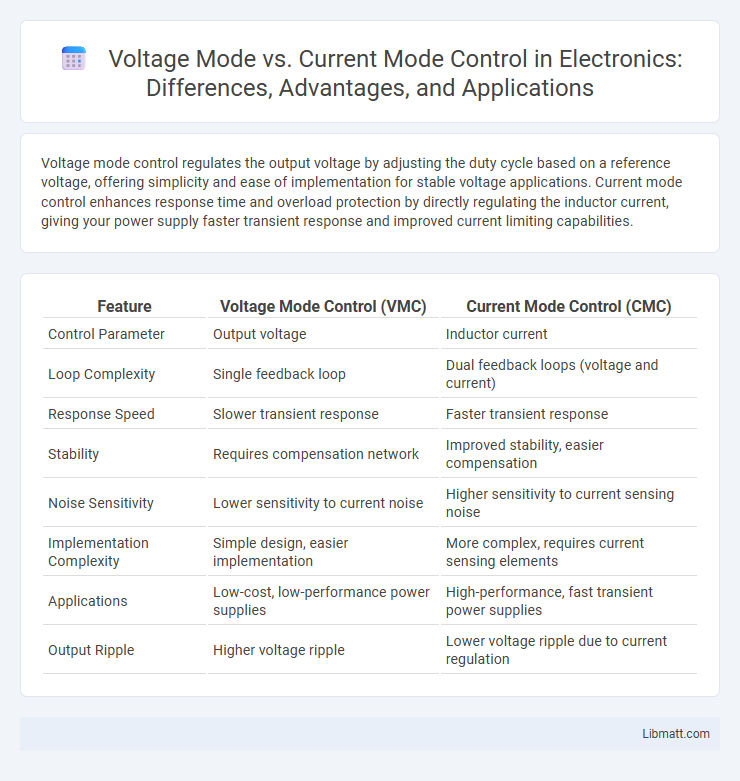Voltage mode control regulates the output voltage by adjusting the duty cycle based on a reference voltage, offering simplicity and ease of implementation for stable voltage applications. Current mode control enhances response time and overload protection by directly regulating the inductor current, giving your power supply faster transient response and improved current limiting capabilities.
Table of Comparison
| Feature | Voltage Mode Control (VMC) | Current Mode Control (CMC) |
|---|---|---|
| Control Parameter | Output voltage | Inductor current |
| Loop Complexity | Single feedback loop | Dual feedback loops (voltage and current) |
| Response Speed | Slower transient response | Faster transient response |
| Stability | Requires compensation network | Improved stability, easier compensation |
| Noise Sensitivity | Lower sensitivity to current noise | Higher sensitivity to current sensing noise |
| Implementation Complexity | Simple design, easier implementation | More complex, requires current sensing elements |
| Applications | Low-cost, low-performance power supplies | High-performance, fast transient power supplies |
| Output Ripple | Higher voltage ripple | Lower voltage ripple due to current regulation |
Introduction to Voltage Mode and Current Mode Control
Voltage Mode Control regulates the output voltage by adjusting the duty cycle based on the error between the reference and feedback voltage, making it simple and widely used in linear and switching power supplies. Current Mode Control enhances system response and stability by directly controlling the inductor current, providing inherent overcurrent protection and faster transient response. Both methods are fundamental in power electronics, with Voltage Mode Control favored for steady-state accuracy and Current Mode Control preferred for dynamic performance and protection features.
Fundamental Principles of Each Control Method
Voltage Mode Control regulates the output by adjusting the duty cycle based on the difference between a reference voltage and the output voltage, relying on a single feedback loop to maintain voltage stability. Current Mode Control incorporates an inner current loop in addition to the voltage loop, directly controlling the inductor current to improve response speed and provide inherent overcurrent protection. These fundamental principles affect the dynamic performance, noise susceptibility, and complexity of power supply design.
Key Differences Between Voltage Mode and Current Mode
Voltage mode control regulates the output voltage by adjusting the duty cycle based on the error between the reference voltage and the output voltage, whereas current mode control directly regulates the inductor current, improving response time and providing inherent overcurrent protection. Voltage mode control typically requires an external compensation network for stability, resulting in slower transient response, while current mode control benefits from simplified compensation and enhanced dynamic performance. The choice between voltage mode and current mode control depends on factors such as load characteristics, required transient response, and complexity of implementation.
Advantages of Voltage Mode Control
Voltage Mode Control offers simpler implementation and easier compensation design, making it ideal for applications where cost and complexity must be minimized. It provides better stability under steady-state conditions and is less sensitive to noise, ensuring consistent performance in various power supply environments. Your choice of Voltage Mode Control can lead to improved control bandwidth and straightforward feedback loop tuning, enhancing overall system reliability.
Advantages of Current Mode Control
Current Mode Control offers enhanced system stability by providing a faster response to load changes compared to Voltage Mode Control. It inherently provides overcurrent protection and simplifies compensation design by directly controlling the inductor current. This method improves dynamic performance, reduces output voltage ripple, and enables precise current limiting in power converters.
Applications Suited for Voltage Mode vs Current Mode
Voltage mode control excels in applications requiring simple design and effective performance at low frequencies, such as linear regulators and power supplies for audio and video equipment. Current mode control is better suited for fast transient response and precise current limiting, making it ideal for switching power supplies, DC-DC converters, and applications with varying load conditions. Your choice between the two depends on the specific requirements for stability, response speed, and load dynamics in your electronic system.
Stability Considerations in Both Methods
Voltage mode control offers simplicity but can face stability challenges due to slower loop response and susceptibility to input voltage variations. Current mode control enhances stability by providing inherent overcurrent protection and faster response to load transients, improving dynamic performance. Understanding these stability considerations helps you select the appropriate method for your power supply design, ensuring reliable operation under varying conditions.
Design Complexity and Implementation Challenges
Voltage mode control features simpler design architecture with fewer components, making it easier to implement but often requires precise compensation network tuning to ensure stability. Current mode control introduces increased design complexity due to the need for accurate current sensing and dual-loop feedback, which can complicate implementation and increase component count. Your choice should balance the ease of design against the benefits of improved dynamic response and protection offered by current mode control.
Performance Under Transient and Dynamic Loads
Voltage Mode Control offers slower transient response and less precise regulation under dynamic load changes due to its reliance on output voltage feedback alone. Current Mode Control enhances performance by directly regulating inductor current, providing faster response times and improved stability during rapid load transients. Your system benefits from reduced overshoot and better load regulation when employing Current Mode Control under dynamic operating conditions.
Choosing the Right Control Method for Your Power Supply
Voltage mode control offers simplicity and ease of implementation, making it ideal for power supplies with stable input voltages and less demanding transient response requirements. Current mode control provides superior line and load regulation with faster response times, especially beneficial in applications requiring tight output voltage control and enhanced protection against overcurrent conditions. Selecting the right control method depends on your power supply's performance priorities, complexity tolerance, and application-specific demands such as transient response and stability under varying loads.
Voltage Mode vs Current Mode Control Infographic

 libmatt.com
libmatt.com